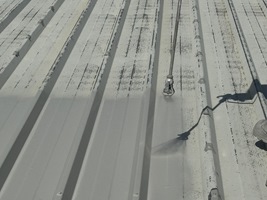Can Metalseal be applied by airless spray?
Metalseal 20 is a spray on metal roof coating with BBA certification.
See the video below showing an independent Liquasil Approved Installer spraying a metal roof in May 2024.
This project is around 11,000 sq metres in total. Three spraying teams are employed on the roof at any one time.
Each spray applicator can achieve up to 1000 sq metres per day in good weather conditions – this means minimum wind (to reduce the chance of over-spray), no rain and no dew on the roof in the mornings.
A single 20 litre tin of Metaseal achieves a coverage rate of approximately 60 sq metres, or 3 sq metres per litre excluding wastage.
With a product warranty of 25 years for a single coat application, this makes Metalseal one of the most cost-effective, spray on metal roof coating products available for the specification market.
As you can see from the video, industrial roof coatings do not have to be dull as ditch wate, nor do they have to look like rice pudding!
Metalseal is a spray on metal roof coating designed and made in the UK by Chartered Building Surveyors and is specified throughout the UK by many of the UK’s leading building surveying practices.
In addition to application by airless spray, Metalseal can also be brush or roller applied if preferred.
Brush and roller application is recommended where there is a greater risk of overspray onto vehicles or other buildings, but spraying is usually much faster, all things considered.
Spray Application of Metalseal 20
This video shows Metaseal 20 being spray applied to a metal roof.
Notice how cleanly the coating is applied. Spray application is much faster than brush or roller application, but care must be taken to avoid overspray.
Metalseal should not be sprayed in windy conditions, but even when there is no wind, a sudden gust can appear without warning.
Keep cars away from all spray painting projects, especially Metalseal 20, because we designed it stick!


